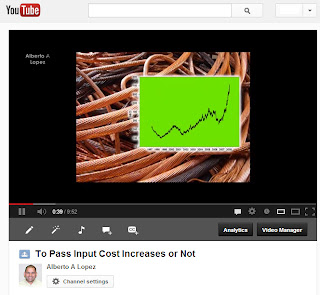Back in August 10, 2010 I wrote an article for a electronics retailer buying group. I think that it is an interesting read, even after so much time has passed. I hope that you enjoy it.
Retailer Under Attack
What would you do if your largest and most power competitor publicly announces they are coming after you; matching your products and service selection and aggressively discount them? This is what happened to Best Buy (
BBY) when
Wal-Mart announced that it would attack BBY, the
Category Killer of the electronics industry. “Wal-Mart aims to dominate consumer electronics” read the Dallas Morning News article on December 15, 2005; just one of the papers covering the story. Every analyst expected BBY to suffer the same fate as
ToysR US and other previously thought unstoppable Category Killers who experienced severe drops in market share after Wal-Mart targeted their market.
After an impressive multiyear expansion that started after it went public in 1985, BBY had grown to 668 US stores by 2005 and begun to face the same challenges that trouble other mature companies; it already had penetrated all the best markets and had only secondary or in some cases tertiary markets to go after. In colloquial terms, all the low hanging fruit had already been picked. Moreover, BBY knew that size alone would not be enough to compete with the largest of all retailers. Wal-Mart would surely target sales drivers like TV’s and leave no room for profitability.

Wal-Mart, on the other hand, had the clear advantage of being the most efficiently run business in retail. Under Toyota’s Keisen model, any part within a supply chain that adds cost but does not add the kind of value consumers would pay for must be eliminated. In other words, a warehouse that does not reduce supply costs should shut down because consumers do not view additional warehousing as a product features worth paying a premium for. If BBY wanted to compete, it had to perform with equal or superior efficiency. In Kaisen terms, BBY needed to eliminate all operational “waste”. Except that BBY had already spent millions of dollars improving most of its processes. Firms of the caliber of Andersen Consulting had previously scrutinized every aspect of BBY s internal business. This left the question of what else could be improved.
An effective mechanism to eliminate waste built within products is through driving suppliers to do so. Suppliers often sell to both contenders and are therefore agnostic about who wins the retail battle. As a result, such suppliers have no real interest in becoming more efficient and refuse to change their bloated models. Why should they? They are facing selling the same number of goods but at reduced prices. A new method must be found.
Enter BBY’s direct sourcing team. In 2003 BBY opened offices in Shanghai as the next step of a promising plan that had the implicit intent of reducing supply chain costs. By buying directly from China, BBY would eliminate all profits and commissions previously kept by “the brand”, its distributors, its independent sales representatives and all costs incurred in additional warehousing, handling and shipping. The project has been quite ambitious.
Any initiative that eliminates branded products creates the risk of removing value from a retailer’s shelves. Making the change to white labels is far from easy. In this case, BBY made the bet that its customers would shop at its stores for its reputation and not because of any product or brand within its walls. After all, branded products only begun to receive their present attention after an explosion in marketing that started during the 50’s. Moreover, many companies in the US and Europe have successfully deployed store brands like
Costco’s Kirkland without any sign of value dilution. So, the experiment begun.

Prior to their direct program, BBY would sell a home audio/video cable from a well known brand for $39.99; the same price that it now sells its Insignia cables for. As part of the program, Insignia, Rocket Fish,
Geek Squad and
Dynex are BBY s own directly-sourced brands and serve to create assortment diversity within the stores. Interestingly, consumers never expressed disapproval for the not so obvious change. In fact, the data shows that Insignia cables sell just as well as the old branded cables did, regardless of Insignia’s lack of pedigree and the fact that the other cables’ supplier had in fact created the concept of higher “per-square-foot” profits.
BBY’s gains do not reside within the selling price. Instead, the real magic happens at the cost. Previously, BBY would pay around fourteen dollars for the old cable while it now lands its Insignia cable for about four dollars. It is important to note that the fourteen dollars was already the industry’s lowest price since BBY s buyers are arguably the best in the planet. While at first sight the $10 difference may not seem big enough to warrant excitement, especially for a retailer that sells close to $50 billion in electronic gizmos a year, a little bit of math demonstrates otherwise. With 180,000 mostly Blue Shirts and Geek Squad employees, the company’s $1.3 billion in yearly earnings translate into $28.14 in net earnings, per employee, per day at work. So, to more than double it profits, BBY only needs to drives its employees to constructively offer Insignia cables to the same customers that would otherwise buy the equally priced alternative cables. This is just three customers, per employee, per day!
In essence, a single
SKU bought directly has the potential to double company profits in a way that doubling the number of stores may not. BBY s direct sourcing team brings in not one but hundreds, if not thousands of SKU’s into their stores. Furthermore, Wal-Mart s customers do not seem to be willing to pay the same premium price as BBY s customers. In a world of big boxes, BBY is the specialist out of the two. Consequently, Wal-Mart is not able to match BBY s profitable performance even when it too sources directly from the orient. These facts have given BBY tremendous competitive power even during the recent recession. BBY is able to discount all of its key category drivers as deeply as Wal-Mart and still emerge more profitable.
Making the change to a direct model is difficult and expensive. BBY has spent millions of dollars and thousands of headaches, but the net result is that BBY withstood attacks by the largest retailer in history. Likewise, direct sourcing should be a must for any retailer with true growth ambitions. Since most retailers are too small to match BBY s investment powers, syndication among retailers and willing suppliers who can smooth the path to direct sourcing are paramount.
Being a member of the buying group takes care of the syndication issue. What is now left is the search for willing partners. The challenges here are several. First, items such as lead times and payment terms will change because direct buying is all about getting no frills. While BBY demands the right to return any products to its local vendors at any time and for a full cash refund, there are no returns crossing the ocean back to China, for example. A good supplier will make the transition into the new business model easy to navigate. Second, existing suppliers have no real interest to sell the same number of units at much lower prices; so new vendors may be needed. Third, by definition new suppliers will not be found within the retailer’s professional inner-circle; a fact that will make the transition awkward at best.

Fourth, the retailer must forgo all perks such as Ferrari rides or
CES rock-band parties because these are the precise costs that end up driving all prices upward. The question here is simple: should the retailer use “its” money on a meal bought by the supplier or as fighting arsenal to overtake the competition. The answer may not so obvious since most retailers have repeatedly opted for the former.
Emulating BBY s program will not be within every retailer’s reach. There are many businesses that are too small or have diverging purchasing patterns that would get in the way of efficiency. On the other hand, the buying group members with converging purchasing behavior create the kind of environment which is conducive to successful direct sourcing, especially when aided by willing suppliers.
Jack Welch, former CEO to General Electric promoted the concept of a
boundaryless organization: a company that adopted ideas that came from anywhere, even the competition. Likewise, learning from BBY may not be to everyone’s liking. In any case, the evidence and the results are too robust to ignore. If the road to profitability is already treacherous, why also make it much longer. Start now!
























